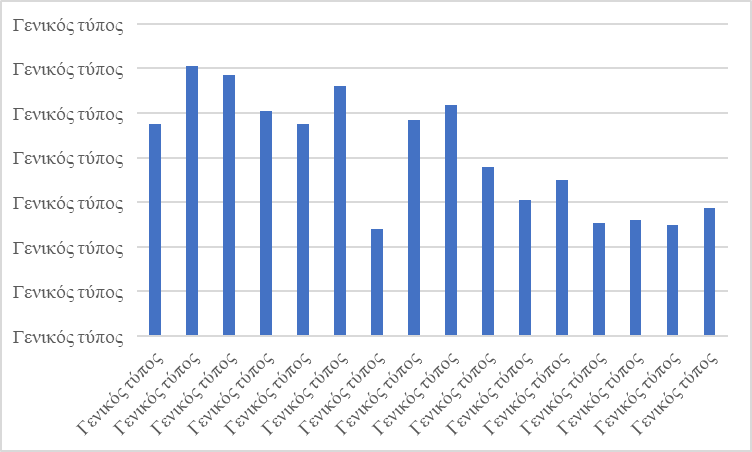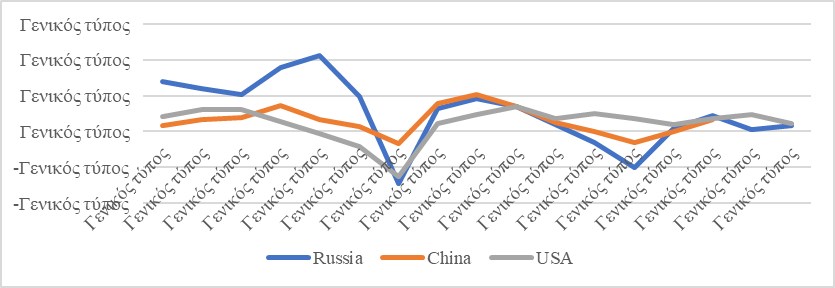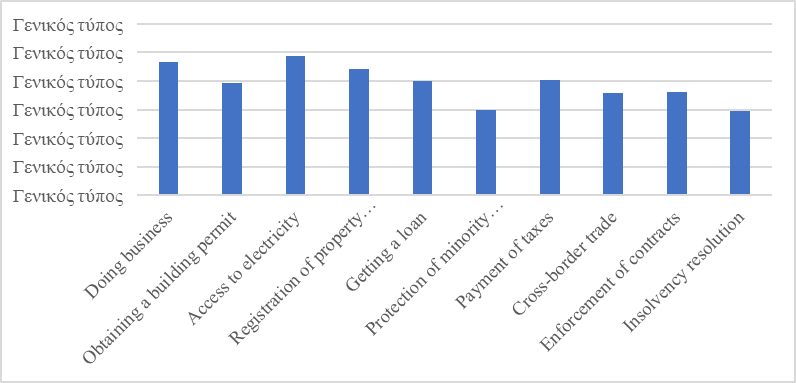Abstract
In recent years, the rate of growth of the economy of Russia has slowed down significantly. The reasons were the sharp drop in oil prices, deteriorating trading conditions, and the presence of imbalances in the economy. The above problems can be eliminated with the help of economic growth drivers, special control mechanisms for both the system and its individual elements. The aspects of the development of the economy of Russia are shown through the drivers. There are many points of view about sources of the continuous development. The authors examined the impact on economic growth of the institutional environment, investments, megaprojects for the development of territories, infrastructure, and the digital economy. Despite all the efforts of federal authorities to ensure sustained growth, all the drivers of the economic development used were not effective enough. The reasons are the excessive centralization of public administration, a high level of corruption, the weakness of the Russian financial system, investments mainly in the raw materials industries, high logistics costs, and the country's territorial disunity. For the resumption of economic growth in Russia, it is essential to consider all the gaps and shortcomings of the previous economic development programs, to work out a unified development strategy, to carry out political reforms to accomplish economic relations with other countries.
Keywords: Drivers of economic growtheconomic developmentgrowth potentialinstitutions
Introduction
One of the main trends of the modern national economy is the transition to a post-industrial society, the basis of which is sustainable, high-quality economic growth, which occurs through innovations, the use of digital and communication technologies. To do this, it is necessary to provide special mechanisms for managing the processes of creating complex links to ensure a multiplicative stimulating effect on the economy, which are called drivers. In the process of its development, economic science has always looked for sources that would ensure the sustainable economic development for the national economy. Investment and innovation theories based on the postulates of long-term technological orders are looking for growth factors. When discussing the prospects and opportunities for economic growth, the categories of “points of growth” and “growth drivers” are encountered. Growth points are understood as the potential for the market development, which can develop the economic system (Ivanova & Terskaya, 2015). The drivers of economic growth are a set of complex power mechanisms that catch primary and secondary demand and catalyze impulses, in a certain way including scattered assets that lead to a change in the national economy (Aganbegyan, 2019). The institutional system, digital technologies, infrastructure, territorial features of the country, development of small businesses, and foreign investment can act as drivers of economic growth. Even though Russia possesses many natural resources, not all of them are of high quality and readily available. The economy of Russia is currently capital-intensive, the country's financial system, despite the years of reforms, is not developed, and the problems with human capital have not been resolved. All these problems limit the possibilities for economic growth within the country.
Problem Statement
In the context of the ongoing global changes, instable national and world economy, the search for factors and mechanisms that contribute to continuous progressive growth and development is becoming increasingly important. Modern healthy growth of the national economy involve the active introduction of innovations, which the dynamics of its development depends on. For this, appropriate mechanisms are needed to ensure the creation of complex links of a multiplicative stimulating effect on the economy. Drivers are such mechanisms. They allow for balanced development. They contribute to positive changes in the national economy. Thanks to drivers it is possible to identify new growth points for all sectors of the economy.
Research Questions
The main research questions are: What is the growth driver? What can be the driver of economic growth? Why is it important for Russia to search for mechanisms to ensure continuous development? What features of the Russian economic system can be identified through the prism of drivers? What is the reason for insufficiently effective implementation of growth and development programs? Why the infrastructural problems of the regions have not yet been resolved? What is necessary for Russia to become a legitimate partner in the world market?
Purpose of the Study
The African Capacity Building Foundation, considering the peculiarities of the economic development of African countries, says that the drivers of economic growth should create comprehensive and sustainable mechanisms that should complement and reinforce each other, for example, when planning economic development, consider the state of the environment and the impact of industry on climate change, so as not to harm future generations (The African Capacity Building Foundation, 2017). Banioniene and Dagiliene (2017) propose to rely on neoclassical growth theories when studying the impact on the main macroeconomic indicators of such drivers as: scientific and technological progress, investment in technology. Cohen in his works highlights such a driver as population immigration, which can lead to both a positive effects on the economy of the country (European countries) and a slowdown in the economic development (migration of Mexicans, Cubans, Asians to the United States) (Cohen, 2016). Some economists consider the institutional system and the quality of institutions formed in the economic system that influence all aspects of the national economy to be the independent driver of economic growth (Gorodnichenko & Roland, 2010; Kaasa, 2016;).
Research Methods
During the study, the following methods were used: comparison, synthesis, analysis; methods of mathematical statistics and graphical presentation of results. The authors, using the methods of analysis and synthesis, show the dynamics of Russia's GDP for the period 2013-2018, the annual growth rate of investment. Using the methods of mathematical statistics, it was revealed that investments in the economy of Russia were carried out at a sound level comparable to the level of investment in countries such as China and the United States. Analyzing the studies of the World Bank and the Heritage Foundation Index of Economic Freedom, the authors showed that there is an uneven development of the system of institutions (World Bank, 2020). We can see it in the banking sector, which is weak and dependent on the government, and excessive centralization of state administration. Also, despite the years of reforms, there is a high level of corruption, weakness of the judicial system. Analyzing the state of infrastructure in the Russian economy, it was found that the implemented projects did not solve the problems of individual regions.
Findings
After the deep crisis of the 1990s due to a radical change in the type of economic system, the recovery of the economy of Russia began in 1999, while the economic recovery continued until 2008, which was facilitated by economic transformations, high income from the sale of oil and gas resources. Dynamics of GDP growth in Russia for the period 2003-2018 are shown in Figure
In 2008-2009, during the global financial crisis, GDP growth rates fell by 16%, but economic growth rates were recovering (from 102% in 2009 to 115.9% in 2011) in 2010-2011. Growth rates were slowing down due to the currency crisis and the economy was plunging into recession in 2012-2013. The recession occurred under the influence of the following factors: a sharp drop in oil prices, Russia's participation in the territorial conflict, the imposition of sanctions against a few companies and individuals. Until 2017, GDP growth rates have been steadily declining, which is facilitated not only by deteriorating trade conditions, but also by internal demographic problems and low labor productivity. In 2018, GDP growth resumed, investment inflow increased, mainly due to household savings. But already in 2020, due to the COVID-19 pandemic, Russia's GDP fell by 12% in the second quarter.

Based on IMF forecasts, the growth rate of Russia's GDP in 2025 will amount to 146.7%, which is much higher than the forecasted values of the GDP growth rate for the USA - 125%, Canada - 122.5%, China - 124% (IMF, 2020). Investment is one of the independent drivers of economic growth. In Russia, in the wake of a favorable investment climate until 2008, the volume of investment was quite high compared to other countries (USA, China). Figure

Starting in 2016, the volume of investments in the economy of Russia increased slightly - from 0.9% in 2016 to 1.6% in 2019. In the United States, the largest volume of investments amounted to 4.8% in 2018, in China - 3.5% in 2017. The data presented indicate that investments did not act as the driver of economic growth, while if we compare the level of investments in the economy of Russia with other countries, it turns out that it is not so low. Consequently, the fact that investments did not become the growth driver was caused not by their insufficient volume, but by low efficiency due to the change of the Development Strategy by the Government of the Russian Federation, the inflow of investments mainly in raw materials industries, and the weakness of the financial system.
Due to territorial characteristics of Russia, the government has developed a strategy for transforming individual regions into points of economic growth. 33 special economic zones of Russia were created: 15 zones of industrial-production type (Elabuga, Lipetsk, Togliatti, Titanovaya Valley, Kaluga), 7 - technical innovation (Dubna, St. Petersburg, Technopolis Moscow), 10 tourist and recreational (Elbrus, Baikal harbor), 1 port (Ulyanovsk) (Ministry of Economic Development, 2020).
Despite the huge sums allocated by the state for the development of economic zones, no significant economic effect was achieved. The Accounts Chamber noted the inefficiency of the port and tourist-recreational zones and classified the industrial-production and technical-innovation zones as conditionally effective (Accounts Chamber, 2018). The failure with economic zones gave rise to the search for new forms of the regional development. It was decided to implement megaprojects in certain territories to stimulate the regional development. The holding of the APEC Summit in Vladivostok assumed that the construction of facilities for it would stimulate the development of the cement industry in the Far East (Krasnopolsky, 2012). At the same time, a certain modernization of the cement industry and building materials has taken place in the region. But most of the demand was met by Chinese manufacturers. Thus, China has provided up to 50% of the demand for cement and building materials.
Holding the Olympics in Sochi with the use of state funding assumed that the infrastructure of the country and the Krasnodar Territory would improve, the aggregate demand of the population would expand, the quality and standard of living of households would improve, and the development of the tourism sector would be stimulated. To prepare Sochi for the Games, $ 51 billion was spent. The implementation of this mega-project allowed the creation of new jobs, a world-class resort, but, unfortunately, the effect of the Olympic Games was only at the regional level, which indicates that positive impulses did not transform into the multiplier effect from the implementation of the project due to the weak development of transmission mechanisms that could translate the expansion of demand into general economic growth.
The 2018 FIFA World Cup created new jobs in the cities where the matches were held, the revenue of small and medium-sized businesses increased, primarily due to the high contribution of the construction and tourism industries. In preparation for the championship, most of the investments were directed to infrastructure - transport, utilities and social, which is currently in use. But large infrastructure projects did not completely solve the problems, for example, there is a shortage of year-round highways in some regions, there are no air communications in some hard-to-reach areas, and logistics costs are high, which negatively affects the competitiveness of Russian goods both on the domestic and foreign markets. If we consider the features of the institutional environment of the Russian Federation, then studies of various world organizations reflect a heterogeneous picture. The World Bank conducted a study in 2020 that looked at the administrative aspects of business activity. Russia, according to the World Bank, ranks 28th out of 190 in the rating with a total score of 78.2 out of 100 possible (World Bank, 2020). The highest scores (Figure

As stated by the Heritage Foundation Index of Economic Freedom, Russia ranks 94th place in the 2020 Index. For the first time, the economy of Russia was assessed as moderately free after more than ten years of its stay in the rating of mostly not free. The highest ratings were given to such indicators as freedom of business (80.2) due to the simplification of obtaining a building permit, fiscal health due to the simplification of the tax payment procedure for economic entities received a rating of 98.7, freedom of investment - 30, financial independence - 30, freedom of labor - 52.1, judicial efficiency (44.4) and government honesty - 41.3% have low indicators, which is associated with the subordination of the judicial system, a high level of corruption, a connection between officials and criminal structures, the imperfect investment base and a high share of state ownership in the banking sector (Heritage Index of Economic Freedom, 2020).
Despite the differences in the level of the development of institutions, both studies illustrate excessive centralization of public administration, the presence of dependence of all spheres of public and economic life on actions of officials, insufficient protection of citizens and business in the financial sector, the judicial system, and in the field of investment. The ongoing economic digitalization is transforming all existing institutions, as well as creating new opportunities for economic growth. Russia has a powerful potential for the development of digital technologies in the field of e-government functioning, the development of information and communication technologies, the share of population and business connection to the Internet, and the development of digital infrastructure. However, the further development of the digital economy should eliminate the risks of disrupting the uninterrupted operation of networks, ensure a high level of customer protection, reduce information risks associated with laundering illegal income.
Conclusion
The study examined several drivers of economic growth, potentially capable of providing a new quality of economic growth for Russia. Most of them failed to provide a sustainable multiplier effect and turn opportunities into a real increase in the volume of national income. The reasons are rooted in the system of Russian institutions, the priority of the development of raw materials industries, the centralization of power, and the weakness of drivers. The insufficient development of the transport infrastructure and the capital intensity of the economy of Russia limit growth opportunities within the country. In such conditions, Russia does not generate impulses for economic growth in the domestic market but is embedded in development pathways that are emerging in other countries. These problems can be solved by developing infrastructure, providing better access to domestic markets in all regions of Russia, and overcoming administrative barriers. For the Russian Federation to become a full partner in the world market, technological and economic cooperation with developed countries is necessary, and the improvement of political and economic relations will allow Russia to redirect part of funds from the military sector to the development of innovations in other industries.
References
- Accounts Chamber (2018). Accounts chamber bulletin № 11 (November). 2018. https://ach.gov.ru/statements/byulleten-schetnoj-palaty-11-noyabr-2018-g-933
- Aganbegyan, A. G. (2019). On drivers of socio-economic growth. Scientific Works of the Free Economic Society of Russia, 218, 180-208.
- Banioniene, J., & Dagiliene, L. (2017). Opportunities to catch up advanced countries by investing in technologies. Montenegrin Journal of Economics, 13(1), 111-123.
- Cohen, E. (2016). Effect of welfare and employment policies on the correlation between migration and unemployment. Journal of Scientific Papers Economics and Sociology, 10(1), 246-264.
- Federal State Statistics Service (2020). National accounts. https://rosstat.gov.ru/accounts
- Gorodnichenko, Y., & Roland, G. (2010). Culture, institutions and the wealth of nations. https://www.nber.org/system/files/working_papers/w16368/w16368.pdf
- Heritage Index of Economic Freedom (2020). Index of economic freedom: Russia. https://www.heritage.org/index/country/russia?version=675.
- IMF (2020). World economic outlook database, October 2020. https://www.imf.org/en/Publications/WEO/weo-database/2020/October
- Ivanova, L. N., & Terskaya, G. A. (2015). Growth points and growth drivers: To the question of the content of concepts. Journal of Institutional Studies, 7(2), 121-133.
- Kaasa, A. (2016). Social capital, institutional quality and productivity: Evidence from European regions. Journal of Scientific Papers Economics and Sociology, 9(4), 11-26.
- Krasnopolsky, B. (2012). Problems and prospects of Russia's integration in the Asia-Pacific region: Assessment of the results of the APEC summit in Vladivostok. Spatial Economics, 4, 180-182.
- Ministry of Economic Development (2020). Special economic zones. https://www.economy.gov.ru/material/directions/regionalnoe_razvitie/instrumenty_razvitiya_territoriy/osobye_ekonomicheskie_zony/
- OECD (2020). Investment (GFCF). https://data.oecd.org/gdp/investment-gfcf.htm
- The African Capacity Building Foundation (2017). Drivers of economic growth in Africa: Opportunities, financing, and capacity issues. https://elibrary.acbfpact.org/acbf/collect/acbf/index/assoc/HASHeb20/853f4d7e/76d2377c/58.dir/Occasional%20Paper%2029%20En.pdf
- World Bank (2020). Ease of doing business in the Russian Federation. https://www.doingbusiness.org/en/data/exploreeconomies/russia
Copyright information

This work is licensed under a Creative Commons Attribution-NonCommercial-NoDerivatives 4.0 International License.
About this article
Publication Date
30 April 2021
Article Doi
eBook ISBN
978-1-80296-105-8
Publisher
European Publisher
Volume
106
Print ISBN (optional)
-
Edition Number
1st Edition
Pages
1-1875
Subjects
Socio-economic development, digital economy, management, public administration
Cite this article as:
Trubetskaya, O. V., & Lunin, I. A. (2021). Growth Drivers In The Economy Of Russia. In S. I. Ashmarina, V. V. Mantulenko, M. I. Inozemtsev, & E. L. Sidorenko (Eds.), Global Challenges and Prospects of The Modern Economic Development, vol 106. European Proceedings of Social and Behavioural Sciences (pp. 546-552). European Publisher. https://doi.org/10.15405/epsbs.2021.04.02.66

